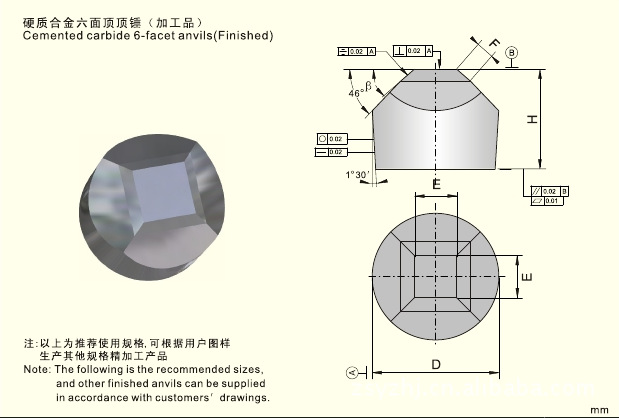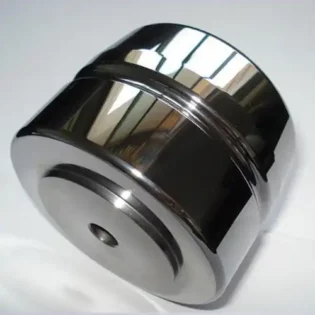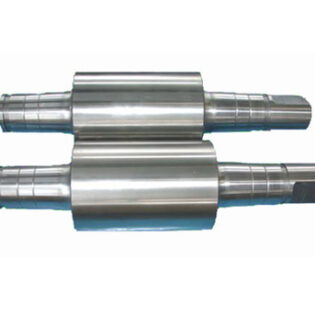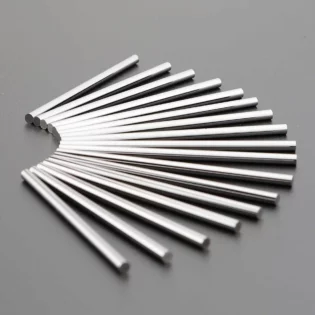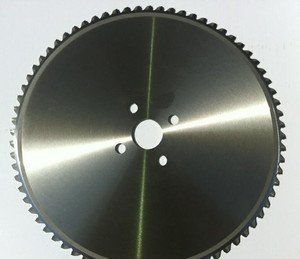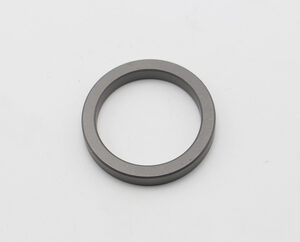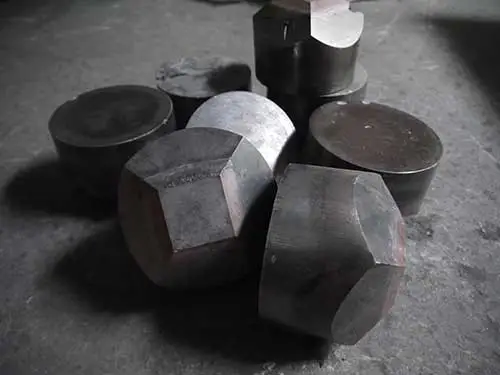
Production key points for cemented carbide anvils
- Ensuring uniform structure: It is crucial to ensure the uniform distribution of carbon in cemented carbide anvils. Since cemented carbide anvils are solid large products, during the removal of the binder, a certain amount of carbon residue will be left in different parts of the anvil, leading to a carbon gradient. This carbon gradient does not align with the required structure of the cemented carbide anvil and should be minimized or eliminated.
Methods such as continuous debinding and sintering or intermittent delubrication and atmosphere sintering can be employed to achieve this. In the process, low-temperature and slow debinding methods are used based on the size of the anvil to remove the binder. This helps to control the carbon gradient within a narrow range.
- Ensuring temperature uniformity during sintering: Using a sintering furnace with an inner chamber can guarantee temperature fluctuations at each point to be less than 3 degrees. This ensures consistent sintering throughout the anvil.
- Selection of raw materials: The choice of raw materials for cemented carbide anvils is also important. Through extensive experiments, it has been proven that using raw materials with a concentrated particle size distribution results in a more uniform alloy structure, reducing the occurrence of coarser or finer grains.
- Stress relief and aging treatment: Generally, the tissue stress generated during sintering and the residual internal stress after precision machining can cause fractures in cemented carbide anvils. Before use, the anvils should undergo aging treatment to eliminate or reduce residual stress and enhance their resistance to fracture under alternating loads. Aging treatment methods include natural aging, oven aging, oil quenching aging, vacuum aging, ultrasonic aging, etc. Natural aging should be carried out for a minimum of one month, while oven aging should be conducted at a temperature below 250°C for at least 72 hours.
By paying attention to these key points, the production of cemented carbide anvils can ensure their quality and performance in diamond synthesis processes.

Carbide anvil grades
The grades of cemented carbide anvils include YG6, YG8, and YG12x. YG6 grade cemented carbide consists of 94% WC (tungsten carbide) and 6% Co (cobalt), with WC and Co powders in medium particle size as the main components. The high content of hard phase WC ensures the compressive performance requirements of the cemented carbide anvil. However, the lower content of the binder phase Co somewhat affects the tensile strength of the cemented carbide anvil and makes it prone to cracking during diamond synthesis. Additionally, controlling the C content in YG6 cemented carbide anvils presents certain difficulties, as it is susceptible to the formation of free carbon or eta-phase, which can affect the performance of the anvils during use.
YG8 grade cemented carbide contains 92% WC and 8% Co, making it a medium particle size cemented carbide. It exhibits excellent compressive and tensile properties and has a longer service life with fewer occurrences of anvil cracking in the early stages.
YG12x grade cemented carbide is a fine particle size cemented carbide. With a certain Co content, the smaller the grain size of WC, the higher the density, hardness, and compressive strength. It is considered an ideal material for cemented carbide anvils.
Correct usage of cemented carbide anvils
- Proper fit between the cemented carbide anvil and the steel ring: It is important to ensure the material of the steel ring and the correct installation of the cemented carbide anvil with precise taper angles. The taper angle between the cemented carbide anvil and the steel ring should be consistent, with a contact area of at least 90%. The installation height should be reasonable, typically 8-10mm for diameters below Φ127mm and 10-12mm for diameters above Φ127mm. The cemented carbide anvil should not have point contact with the size pads, to avoid stress concentration.
- The fastening screws of the steel ring should be freely adjustable without significant resistance.
- The installed size pads should have even contact with the working cylinder piston and be securely fastened.
- When installing the cemented carbide anvil, it should be leveled using a calibration block. Gently tap the calibration block between the two anvils, and there should be no shaking. Finally, the adjusted six cemented carbide anvil blades and the solid block of the synthetic square should align at the center, with the center still within the center of the cemented carbide anvil surface. The synchronicity of the three directions of the solid block should not exceed 0.2mm.
- The press machine should have good adjustment accuracy, with no leakage, and the synchronicity and alignment deviation should not exceed 0.2mm. After aligning the six cemented carbide anvils with the solid block, further assessment should be done based on the synthetic block and synthetic rod. The rod end should be round and not elliptical or eccentric, ensuring that the synthetic rod is a regular cylinder with no abnormal phenomena such as a trumpet-shaped end. Otherwise, the alignment of the cemented carbide anvils should be further adjusted.
The processing accuracy of the steel ring and size pads should meet the requirements. The inner surface of the steel ring should have a smoothness of Ra1.6, and the roundness and taper angle should match the positioning tolerance of the cemented carbide anvils. The parallelism of the size pads should be ≤0.02mm, and they should have appropriate hardness. The baking temperature and time of the solid block should be moderate to prevent accidents caused by poor pressure transmission performance or excessive moisture content. The conductive steel ring should have no rust, cracks at the edges, and should not turn blue after baking. Proper moisture-proof storage is necessary.
During assembly, check the solid blocks for cracks, impurities, and whether thin and thick steel plates are mistakenly placed or reversed. Before placing the block, clean the surfaces of the six cemented carbide anvils to avoid hammering or electric shocks. Each cemented carbide anvil must be fully scraped on all four sides before synthesis to prevent collapsing. When advancing the empty stroke, inspect the actions of the six cylinders and check for any misoperation of the fixed cylinder and pause when the moving cylinder is in place. During thermal stop and pressure release, the holding time should be no less than 1 minute to prevent pressure release explosions.
